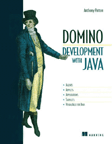By Steven Lacher
I was excited to review Anthony S. Patton's Domino Development with Java from Manning Publications Company, because I'm quite familiar with his work. His Practical LotusScript is a wonderful book that I've made reference to and often used professionally in my work as a Lotus Notes and Domino developer. It's one of my most invaluable LotusScript resources, and it's a book I recommend to anyone who aspires to be a great "LotusScripter."
Like Practical LotusScript, Domino Development with Java (pictured in Figure A) provides some excellent reference material.
FIGURE A
Domino Development with Java provides great information. (click for larger image)
Chapter 22 gives superb information about performing Java development for Domino in an outside IDE. Also, Chapters 23 through 25 contain very valuable information about referencing information on Domino servers when creating applets and servlets.
The rest of the book discusses standalone applications, threading in Java classes that access a Domino server, JDBC (Java Data Base Connectivity) syntax, Lotus connector usage, and WebSphere. There's also a brief discussion of a few third party tools.
In the first two chapters of the book, Mr. Patton offers some compelling reasons why a traditional Domino developer would want to learn Java. Chapter 3 contains a basic introduction to Java syntax and concepts, however, as a beginner, you shouldn't consider it a replacement for an actual class or a book in pure Java itself. The fact is, if you don't know Java, you're not going to learn it from this book, but it certainly does whet the appetite if you're only starting out in this direction.
The next two chapters contain information that is specific to Java coding in Domino--issues about memory handling and some niceties about the Designer UI (User Interface).
Chapters 6 through 17 and chapters 19 and 20 describe common Java classes that have equivalent LotusScript functionality. If you have done LotusScript development in the past, then you may not necessarily find these sections as useful, as they cover some basics like walking a view or drilling down to an item from a document.
One of the reasons Mr. Patton's Practical LotusScript is an invaluable resource is that it addresses the common practices and pitfalls of an experienced Domino developer with years of diverse learning. Unfortunately, I didn't see as much of that in this new book, so for Java programmers out there hoping to perhaps learn a bit about Domino, you may not find everything you're looking for.
Don't get me wrong; all the information presented in the book is correct, and a lot of it is stuff you'd be hard pressed to find anywhere else. However, some may find it too basic of a book on Domino for it to be of use to a Java programmer, and too basic of a book on Java for it to be of use to a hardcore Domino developer.
That being said, Domino Development with Java can be recommended as an information resource, and while it may not be the definitive source for learning everything you need to implement Java in a Domino application, it's certainly a great place to start thinking about the idea.
Steven Lacher is a Principal Ceritfied Lotus Professional Application Developer in R4 and R5, specializing in LotusScript. He's also an R4 Ceritifed Lotus Instructor. He's worked with Lotus Notes since 1997 and has been in the IT field since 1989. He works for Titan Systems of Fairfax, Virginia and lives in Columbia, Maryland with his wife and son.